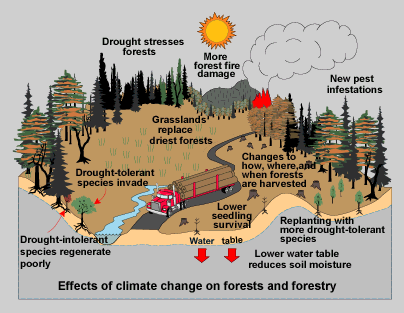| ||||||||||||||||||||||||||||
Proactive disclosure Print version |  Temperature rising: Climate change in southwestern British Columbia Forests in transition Changes in Southern Interior forests
As climate warms, some plant species in British Columbia's Interior will extend their ranges northward and to higher elevations. Drought-tolerant trees, such as Douglas fir and Ponderosa pine, will be favoured over trees requiring more moisture, such as spruce. Dry grasslands may replace Douglas fir forests in some areas, and trees will invade alpine meadows. Plants adapted to the new climate will appear first in areas disturbed by fire, logging, and extreme drought. Changes in forest composition, tree growth, fire frequency, and insect infestation will affect how and where trees are harvested and replanted.

Did you know? What will happen to the forests in your community if summers become hotter and drier? How will the British Columbia forest industry adapt to climate change? References Hebda, R.J., 1997, Impact of climate change on biogeoclimatic zones of British Columbia and Yukon, in Responding to Global Climate Change in British Columbia and Yukon, eds. E. Taylor and B. Taylor; Environment Canada and British Columbia Ministry of Environment, Lands and Parks, p. 13-1-13-15.
|